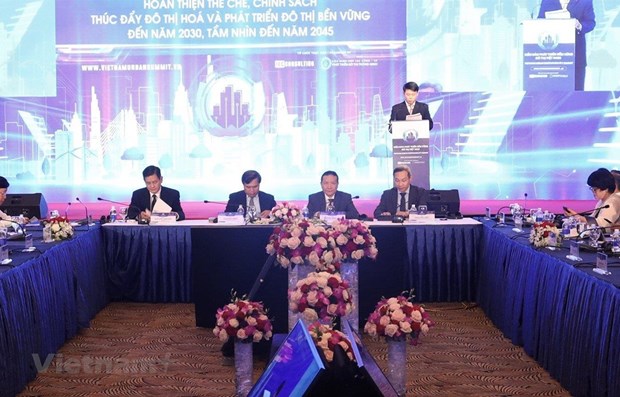Consolidating legal framework to boost urban economy
 At a workshop on urban economic transition towards green, sustainable growth on June 17. (Photo: VNA)
At a workshop on urban economic transition towards green, sustainable growth on June 17. (Photo: VNA)Hanoi (VNA) – The classification and upgrading of urban areas have met requirements regarding land and population, but have yet to deal with quality issues.
Speaking at a workshop on new urban models and urban economic transition toward green, sustainable growth on June 16, Deputy Prime Minister Le Van Thanh said that after more than 35 years of Doi Moi (Reform), Vietnam’s urban system has shown outstanding developments in terms of both quality and quantity.
Vietnam now has 869 urban areas of different types, with harmonious and modern technical and socio-economic infrastructure, helping to improve the living standards of people, the Deputy PM said.
The official emphasised that policies on planning, urban development, housing and the real estate market have been issued concertedly and that the urban economy grows by 12-15%, 1.5-2 times higher than the national average, and contributes around 70% to the national gross domestic product (GDP).
Civilised and modern urban areas, especially centres of science-technology, education and training, have been formed in major cities like Hanoi and Ho Chi Minh City, creating an important premise for Vietnam to implement urban development tasks in the time ahead, he continued.
Dr Nguyen Duc Hien, Vice Chairman of the Party Central Committee's Economic Commission, said urbanisation creates areas with expanded economic space and an open investment environment, adding that infrastructure development has also generated an abundant workforce and big markets.
Urbanisation has also given a boost to industries and services, helped to attract more foreign direct investments, accelerated economic restructuring and led to the formation of development models like urban, smart, and eco-urban areas.
Such urban models have moved economic restructuring towards green growth, competitiveness improvement, job generation and poverty reduction, the official said.
Notably, they have helped to intensify the climate change resilience of urban areas, he stressed.
Meeting only land, population targets
Hien, however, pointed out that there are very few sustainable, green, smart urban areas, and that the urban classification and upgrades have met only land and population targets, but have not yet dealt with quality issues.
There has not been a development strategy during the first phase of smart urban area building, he continued.
He cited statistics as showing that about 300 coastal urban areas will suffer climate change impacts, such as flooding or saltwater intrusion, and around 140-150 mountainous urban areas will be affected by landslides, flooding and drought.
Moreover, urban economic development shows a lack of connectivity and still relies on foreign direct investment, he said, adding that the country’s urban economic growth is mainly driven by five centrally-run cities.
Consolidating legal framework
Given this, the Party Central Committee's Economic Commission has submitted a project to the Politburo to issue Resolution No. 06-NQ/TW on January 24 on the planning, construction, management and sustainable development of urban areas in Vietnam by 2030, with a vision toward 2045.
The resolution will serve as an important foundation to adopt new mechanisms and policies, and create momentum for urban development, significantly contributing to rapid, sustainable socio-economic development.
The resolution outlines major tasks and solutions for sustainable urban development, including studying and consolidating mechanisms, policies and standards, and selecting urban development models that match the requirements of different regions.
Hien said efforts will focus on improving the efficiency of land use while effectively and sustainably using cultural and historic sites, and community spaces like pavements, hospitals, universities, research facilities, logistics and commercial centres, and wholesale markets.
The highlight of urban areas will be the services, processing and manufacturing industries with a digital and circular economy, he noted.
To achieve these targets, tax and fee policies relating to property need to be amended to encourage the effective use of land and housing, and the legal framework should be consolidated./.












